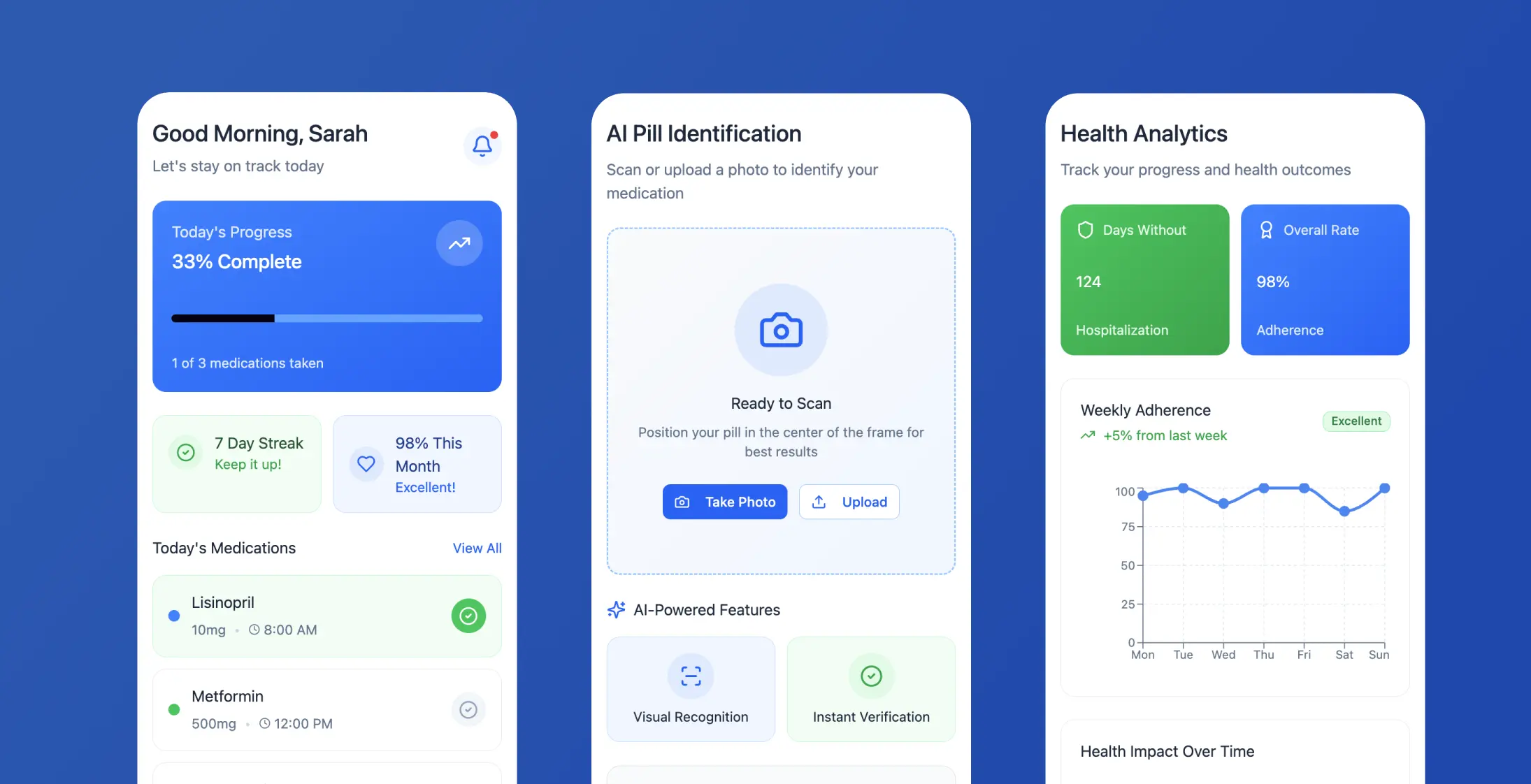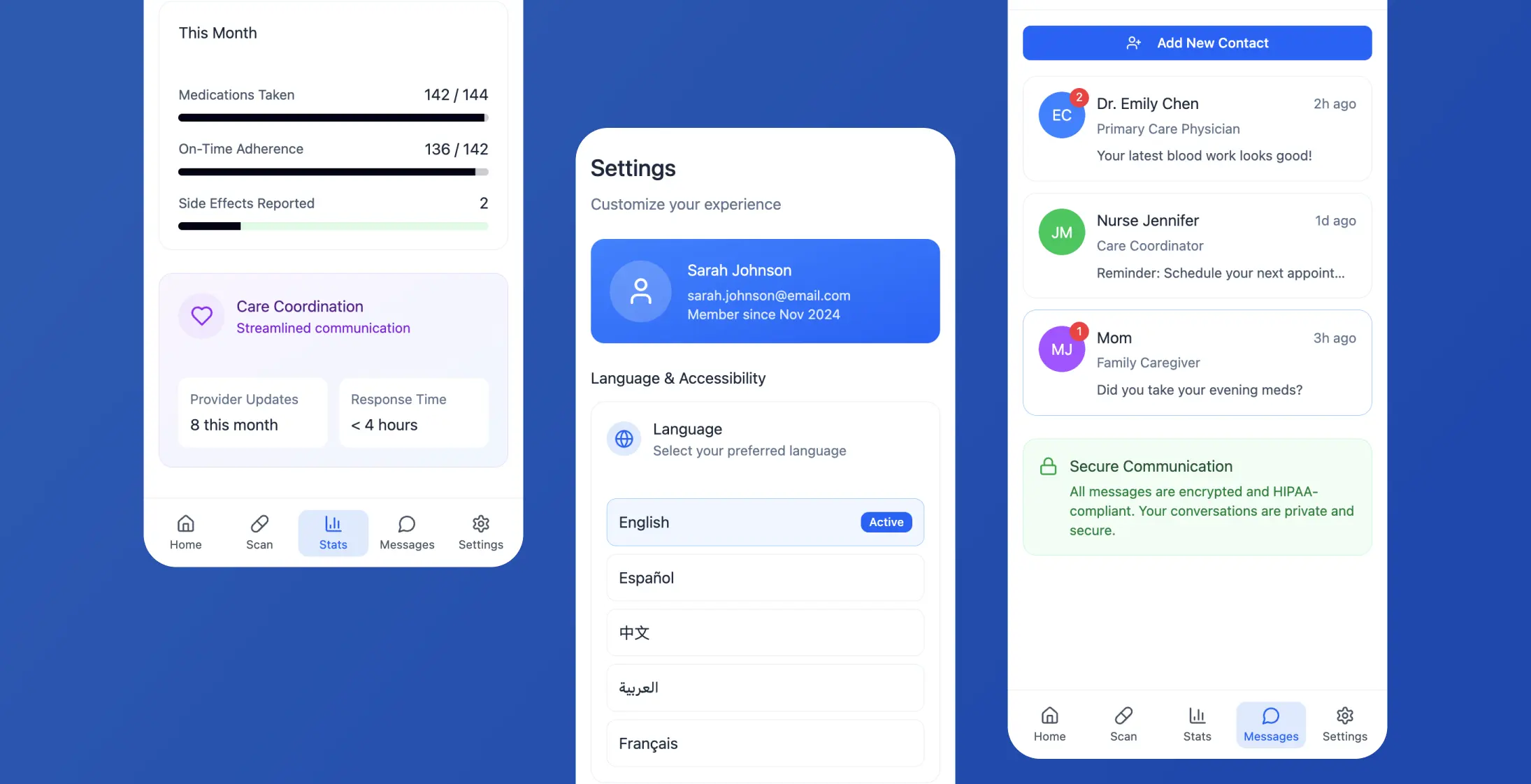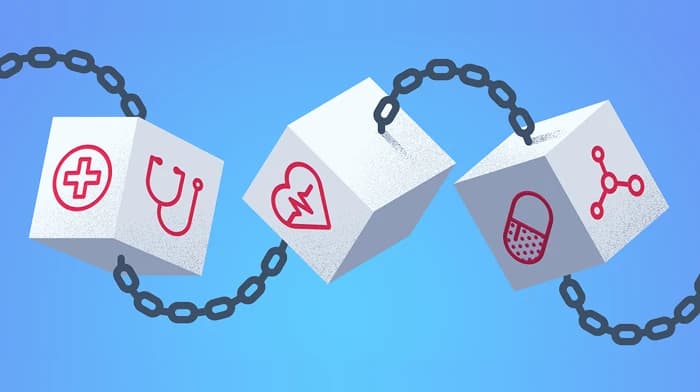

Project Overview
The mobile platform effectively tackled issues related to medication adherence and safety by incorporating features such as pill identification assistance, scheduling reminders, monitoring events and facilitating communication with healthcare providers.
Made enhancements in streamlining care coordination effectiveness by cutting down on provider response times by 52% all the while upholding HIPAA compliance regulations and safeguarded data accuracy.
Managing medications plays a role in healthcare delivery by ensuring safety and effective treatment while fostering better coordination between healthcare providers and patients through various tools and communication methods like paper based lists and pill reminder apps with the aim to report any adverse events efficiently.
Introduction
The mobile platform effectively tackled issues related to medication adherence and safety by incorporating features such as pill identification assistance, scheduling reminders, monitoring events and facilitating communication with healthcare providers.
Made enhancements in streamlining care coordination effectiveness by cutting down on provider response times by 52% all the while upholding HIPAA regulations and safeguarded data accuracy through comprehensive security audits.
Managing medications plays a role in healthcare delivery by ensuring safety and effective treatment while fostering better coordination between healthcare providers and patients through various tools and communication methods like paper based lists and pill reminder apps with the aim to report any adverse events efficiently.
Healthcare Challenges
The healthcare sector is under increasing pressure to enhance medication adherence to improve outcomes and reduce healthcare expenses due to non adherence resulting in a substantial number of fatalities and additional costs every year in the US alone. Moreover managing medication regimens has become more challenging for adults with various chronic illnesses requiring advanced tracking and care management systems.
Navigating through the realm of health solutions involves meeting regulatory standards such as adhering to HIPAA regulations and following FDA protocols for mobile medical apps while seamlessly integrating with established healthcare information systems. The system must cater to individuals with levels of technology familiarity and adhere to accessibility guidelines outlined in the Americans with Disabilities Act. Furthermore supports capabilities and accommodates various cultural backgrounds.
Medication Management Obstacles
Healthcare professionals faced obstacles throughout the process of managing medications. Healthcare stakeholders faced hurdles in managing medications throughout the entirety of a patients treatment journey.
- It was common for patients to encounter difficulties in recognizing medications prompted by changes in pill appearance due to manufacturers or formulations
- Identifying medications became a challenge for patients when pills underwent alterations in appearance due to changes in manufacturers or formulations
- Patient adherence tracking primarily relied on methods that were susceptible to errors
- Patient tracking for adherence mostly depended on techniques that were prone to inaccuracies
- Side effects monitoring typically took place reactively during scheduled appointments than being conducted real time monitoring was absent
- The monitoring of side effects typically occurred reactively during scheduled appointments of being done instantaneously during the course of treatment
Communication barriers between patients and healthcare professionals have caused delays in addressing medication issues. Making adjustments to dosages or responding to adverse reactions promptly Caregivers have struggled with understanding patient medication behaviors which has led to coordination difficulties especially for elderly individuals or those with cognitive impairments Healthcare providers often work with incomplete information regarding patient adherence and experiences with side effects in the time between appointments.
System Integration Challenges
Users were burdened by having to juggle applications due to the scattered tooling landscape which came with interfaces and data formats alongside unique authentication methods for each application they used for managing tasks or information tracking purposes in the healthcare domain leading to challenges in monitoring medication history comprehensively and transitioning care smoothly between healthcare providers or systems.
In areas with varying internet access and compatibility across Android and iOS devices were hurdles to overcome alongside integrating with legacy healthcare systems securely through integration protocols that comply with regulations like audit trails and data encryption while ensuring controlled user access and maintaining user experience standards.
Integration with legacy healthcare systems requires careful planning to maintain security and compliance while ensuring seamless user experience.
Solution Impact
Medication Adherence Crisis Resolution
Removed obstacles to medication adherence by implementing scheduling methods and personalized reminders along with visual pill recognition.
- Reduced hospitalizations due to medication by 34% achieved by monitoring adherence and implementing early intervention strategies
- Reduced administrative workload for providers by 28% using automated adherence reporting and exception based workflow management
- Enhanced time clinical assistance by incorporating in depth medication records and monitoring of side effects
- Reduced medication waste by tracking dosages and managing expiration dates
- Decreased visits to the emergency room due to medication mistakes by 41% thanks to pill identification and dosage confirmation
Implemented a strategy for detecting events by tracking symptoms and utilizing machine learning to recognize patterns.
Healthcare Equity and Accessibility
Implemented strategies to tackle healthcare disparities by offering support in languages and incorporating voice guided interfaces along with design patterns for individuals with low literacy levels through comprehensive blockchain consulting.
Facilitated caregiver collaboration using shared access permissions and alert mechanisms.
Transform Your Healthcare Experience
Improve medication adherence by 34% with our intelligent platform.
Platform Architecture
Core Design Philosophy
The platform embraced a patient focused approach to design by combining medication management features in one app that seamlessly integrates with healthcare providers systems while also emphasizing usability for situations with unreliable internet connections.
Computer Vision Technology
The technology of computer vision enables the identification of pills by using machine learning models that are trained on pharmaceutical databases to distinguish medications from manufacturers and formulations accurately. This meets a requirement for users and ensures data verification for precise adherence tracking purposes.
- Convolutional neural network models have been trained using over 50,000 medication samples under lighting conditions and angles
- Real time analysis of images with a 94 percent accuracy rate for prescription drugs
Smart Scheduling System
The smart scheduling system incorporated reminder algorithms that took into account each users behavior patterns and medication schedules along with lifestyle elements. Of time dependent notifications the system adapted based on user actions to enhance the timing and frequency of reminders.
Side Effects Monitoring
The system monitored side effects by using organized symptom reports along with natural language processing to detect reactions to treatments. It was able to connect with decision support systems making it possible for matching with medication adjustments and notifying healthcare providers about noteworthy trends.
Communication Infrastructure
The provider communication channels offered both asynchronous ways to interact securely through messaging and integrated video consultations with the ability to share data effectively. The focus of the system was on integrating clinical workflows rather than adding more administrative tasks to be managed on top of current responsibilities.
Technical Implementation
Data Architecture
The data architecture focused on interoperability by adhering to FHIR standards for compatibility with health records and pharmacy systems in healthcare applications while ensuring privacy through design principles that regulate data collection and sharing practices.
Localization and Accessibility
- Localization across 12 languages is offered with adjustments for medication naming conventions
- Deployment of microservices on Amazon Web Services Elastic Kubernetes Service with scaling according to user activity patterns through advanced fintech solutions
- Event based design involving Apache Kafka for data streaming and alerting providers
Compliance and Security
A thorough audit log that complies with HIPAA and GDPR regulations as FDA 21 CFR Part 11 requirements.
Security Testing Results
| Test Type | Coverage | Results |
|---|---|---|
| Unit Testing | 95% | Code related to medication management functions |
| Integration Testing | 100% | End-to-end processes confirmed |
| User Acceptance | 200+ participants | Accessibility and usability verified |
| Security Testing | Multiple audits | HIPAA compliance maintained |
| Performance Testing | 150,000 sessions | Medication reminders capacity confirmed |
Development Process
Agile Implementation
The project was carried out using a development method that involved two week sprints and focused on integration and ensuring compliance with regulations throughout the process of validation. Each individual feature went through security assessment as validation of its clinical workflow and accessibility before being released to users.
Data Migration
Successfully transferring data from systems necessitated preparation to uphold the seamless transition of medication histories. The system offered features to bring in data from medication tracking formats and CSV exports sourced from health records. When introducing providers to the platform comprehensive training sessions and integration testing within the established processes were conducted to ensure adoption and operation flow.
Risk Management
Key challenges involved ensuring identification of medications and maintaining system functionality during reminder times while complying with regulations in various locations. To address these issues effectively:
- Conduct A/B testing for computer vision models
- Implement region deployment to enhance disaster recovery capabilities
- Undertake reviews of privacy policies across markets
Rollback protocols were in place to quickly address issues by utilizing automated surveillance to identify instances of non compliance with medication and failures in provider communication channels. In times of system maintenance or outages various emergency contact systems were available for alternative communication methods to be utilized.
Results and Performance
Healthcare Outcomes
The platform showed enhancements in outcomes as well as operational and financial performance metrics with a notable increase in patient medication adherence thanks to smart reminders and user friendly tracking interfaces. Provider productivity also saw a boost through automated reporting and exception focused workflow management strategies.
The reduction in healthcare expenses stemmed from a decline in medication based outcomes and fewer trips to the emergency room alongside management of chronic illnesses. The ratings for contentment indicated an user interaction and the perceived worth of an all encompassing medication supervisory skill set.
System Performance
The systems performance metrics have confirmed the architecture choices made and ensured availability and responsive user interfaces to cater to a range of users effectively. Security incidents have been below industry standards while ensuring user accessibility and convenience are upheld at all times.
Provider Feedback
The feedback from healthcare providers showed that 78 percent noted efficiency in managing medications through features like automated adherence tracking and structured patient communication on the system platform. The tool also significantly lowered medication reconciliation errors by 61 percent during transitions in care and hospital discharge processes.
Healthcare providers reported 78% improvement in medication management efficiency through automated tracking and structured communication features.
Lessons Learned
Computer Vision Development
The system for identifying pills using computer vision required a lot of training data and validation to meet the accuracy standards for use successfully. At attempts it achieved a 76% accuracy rate; however further partnerships in the pharmaceutical industry and consultations with the FDA were needed to reach the 94% threshold for ensuring patient safety.
User Experience Design
The original design of the platform tried to pack in all medication management features into an interface which ended up confusing users and lowering adoption rates significantly. By streamlining the user experience and gradually revealing features through progressive disclosure approach helped boost user engagement and enhance medication adherence results considerably.
Integration Obstacles in Traditional Healthcare Systems
Healthcare professionals frequently use health record systems that have restricted API functionalities or outdated integration methods in place. Developing integration tools and ensuring manual data transfer options are available were crucial for getting providers to adopt these systems – even if automated integration was possible from a standpoint.
Regulatory Navigation
Health apps for devices have to navigate through rules and regulations in various regions and countries around the world. Engaging with authorities on by participating in pre submission meetings with the FDA and consulting with state health departments has proven effective in avoiding delays in development and ensuring compliance issues are addressed promptly and effectively.
Technical Challenges
The field of imaging comes with its set of challenges such as dealing with different lighting conditions and distinguishing between generic and brand name pills based on wear patterns. Ensuring that the model is continuously retrained and validated against real world scenarios proved to be more crucial than focusing on the size of the training dataset.
Privacy and User Trust
Concerns were raised by users regarding the privacy of medication data even as they requested sharing with family members and healthcare providers alike. Security measures that allow for control over privacy and clear policies on data usage necessitated user education and multiple design revisions to the interface done in order to implement them effectively.
Offline Functionality
Taking medication often happens in places where the internet connection's not stable which makes it necessary to have features available at all times. For this reason a complex system of data synchronization and conflict resolution is needed to balance the capabilities with real time communication with healthcare providers and emergency alert functions.
User Diversity
Designing interfaces to cater to a range of users from teenagers dealing with conditions to elderly individuals with complex medication routines required incorporating flexible design elements and various ways for users to interact with the system effectively and comfortably. Accessibility features such as voice commands, text options and simplified navigation paths were no longer just nice to haves but essential components in meeting different user needs.
Data Processing Infrastructure
Apache Spark is used for handling data processing and creating features on a scale.
Project Results
- 34% reduction in hospitalizations due to medication issues
- 52% improvement in provider response times
- 41% decrease in emergency room visits from medication mistakes
- 28% reduction in administrative workload for providers
- 94% accuracy rate in pill identification
Key Performance Metrics
Hospitalization Reduction
Due to medication issues
Provider Response Time
Improvement in response times
ER Visit Reduction
From medication mistakes
Pill Identification
Accuracy rate


